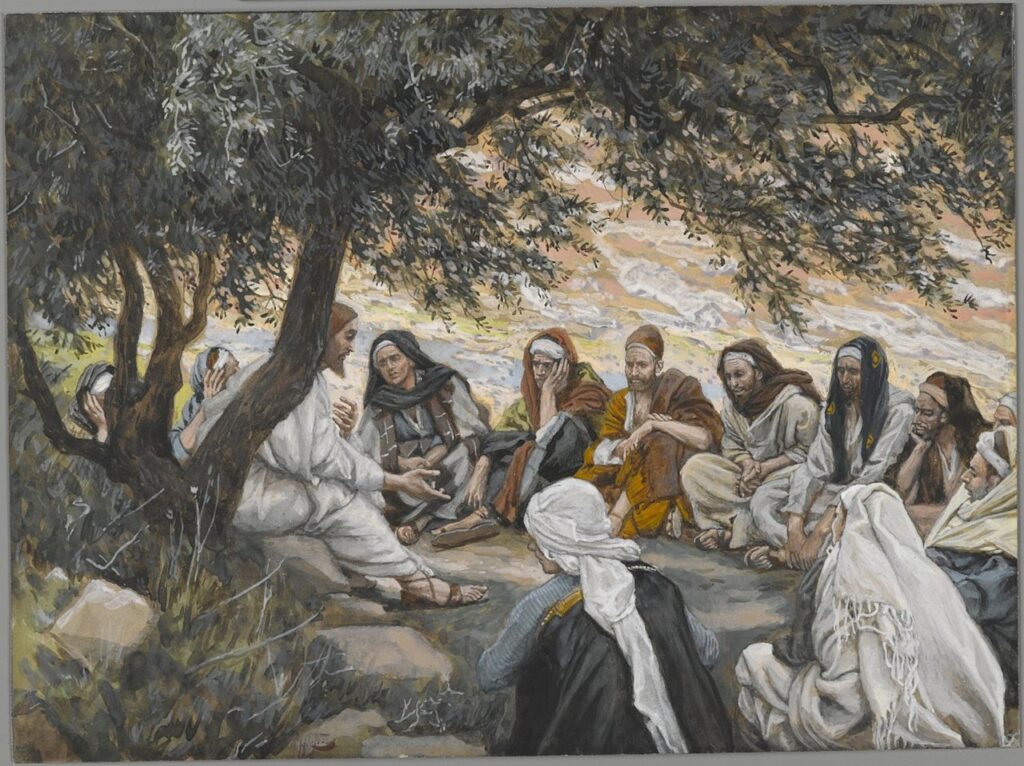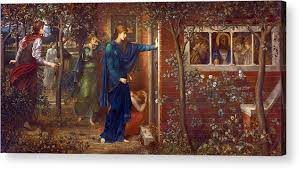Living a life of parables?
(Originally written on August 22, 2020)
A few years ago, I finished reading The Holy Bible; this time, however, I read the Gideons’ version—you know, the red-covered Bibles found in hotel rooms. (During a trip with my husband, I had found one in our hotel room and began to read it; I liked it so much I decided to buy my own.) As I read the Gideons’ translation of the New Testament’s book of Mark, I gained a greater understanding of a few things—especially the ones listed below:
- Christ’s interactions with the Pharisees and Sadducees and Christ’s responses to their relentless scrutiny, criticisms, and accusations.
- Christ’s parables, especially the ones about the old wine in new bottles, and the new cloth sewn onto an old garment
- The nature of the Pharisees’ hierarchical and authoritative relationship to Christ
Mark emphasizes the fact that the self-righteous Pharisees constantly followed Christ, watching His every move and listening to His every word for purposes of fault-finding, accusation, and condemnation. For instance, they watched with sanctimonious anticipation and then vehement accused Christ of breaking the Mosaic Sabbath law simply because Christ picked an ear of corn to eat.

Christ’s Parables As an Effective Teaching Tool
While discussing Christ’s parables with my daughter, Cristi, we compared their multiple hidden meanings and their ongoing relevancy to our present-day circumstances. In his Ensign Magazine article, “Parables of Jesus: The Priceless Parables,” Frank F. Judd Jr. further explains:
The word parable comes from the Greek paraballo, which means ‘to set beside’ or ‘to compare.’3 A parable, therefore, is a simple story in which the narrator compares the common experiences of his listeners to some divine truth (see Bible Dictionary, “Parables,” 740–41).
Jesus primarily employed two types of parables, depending upon His audience. The first is what we might call ‘parables of instruction,’ which the Savior used to teach His disciples and curious seekers about basic gospel principles. Other parables might be described as ‘parables of rebuke’ which the Savior directed toward those who had ill will for Him. The parables of the two sons, the wicked husband-men, and the marriage of the king’s son (see Matt. 21–22), which specifically condemn those who were conspiring against Him, are examples of this type of parable. The Savior sometimes used a single parable to both instruct and rebuke. For example, the parable of the lost sheep teaches on one occasion about Heavenly Father’s genuine concern for our welfare (see Matt. 18:12–14), while on another occasion, it delivers a rebuke to a group of Pharisees and scribes for their self-righteousness (see Luke 15:1–7).
Discovering how to interpret and apply the parables of Jesus is essential to getting the most from them. To interpret a parable, one must study what it meant to them, there, then. To apply a parable, one must ponder what it means to me, here, now. Although there is normally one original interpretation of the elements in a parable, there may be many principles and applications that can be drawn from it.
. . . Elder Dallin H. Oaks of the Quorum of the Twelve Apostles has also stressed that the occurrence of multiple meanings or applications in scriptures ‘underscores the importance of our seeking revelation from the Holy Ghost to help us interpret them.’9 He has also said, ‘The Holy Ghost is a better guide to scriptural interpretation [and application] than even the best commentary.’ Thus, to discover the most appropriate application of a parable ‘our minds need to be enlightened by the Spirit of the Lord‘
(https://www.churchofjesuschrist.org/study/ensign/2003/01/parables-of-jesus-the-priceless-parables?lang=eng).

As stated earlier, the Scribes, Pharisees, and Sadducees shadowed Jesus Christ to entrap, ensnare, and accuse Him. Consequently, these Mosaic leaders repeatedly inserted themselves into Christ’s interactions with others while plotting behind Christ’s back. Sometimes, they seemed to sincerely question Jesus; other times their outright scrutiny was malicious. The scriptures also describe various scenarios highlighting the Pharisees’ subversive methods. The second chapter of Mark says, “the Scribes were sitting there and reasoning in their hearts” as to their potential responses to Jesus, while at other times, they openly questioned and confronted Christ as He preached and performed healings. Despite their manipulative relentlessness, Jewish leaders were unsuccessful in their attempts to outsmart Jesus. And their repeated failures fueled their growing resentment and anger toward Christ—to the point of killing Him.
Applying Parables to Our Everyday Lives
In our discussion, my daughter and I decided upon a few specific personal applications pertaining to the Scribes and Pharisees’ manipulative behavior. We also took personal inventory as we reviewed the “new wine in old bottles and the new cloth sewn onto the old garment” parables and their applicability to our own lives.
For example, the New Testament repeatedly describes Christ’s (and later His apostles’) ability to discern and perceive the hearts, minds, and intentions of people (especially the Pharisees and Sadducees) who sought to deceive, undermine, hurt, and cause harm. The Book of Mormon also provides many examples of the powers of perception and discernment of Christ’s and His disciples. As I’ve suggested in my other posts, I believe that we, too, can pray for these divine spiritual gifts listed in the Apostle Paul’s letters to Corinth, in the Doctrine and Covenants, Section 46, and in Moroni, Chapter 10 from the Book of Mormon. Obviously, our ability to receive these gifts and how to use them is fully dependent upon our faith, righteous desires, and the Lord’s will. The Book of Mormon gives a compelling example of Ammon’s ability to discern the thoughts of King Lamoni:
And it came to pass that Ammon, being filled with the Spirit of God, therefore he perceived the thoughts of the king. Now when the king had heard Ammon’s words, he marveled again, for he beheld that Ammon could discern his thoughts. And the king said: How knowest thou the thoughts of my heart? Thou mayest speak boldly, and tell me concerning these things . . . Now Ammon being wise, yet harmless, he said unto Lamoni: Will thou hearken unto my words, if I tell thee by what power I do these things?’”
(Alma, 35).
Thus, not only did Ammon’s spiritual gift of discernment save his own life, he was also able to convert King Lamoni, and the king’s household to the gospel of Jesus Christ. My patriarchal blessing tells me that I have “the spiritual gift of discernment” which gives me “the ability to sidestep evil . . .” When I pray for divine guidance in using this gift, the Lord has helped me in all aspects of my life. Again, I want to emphasize that this gift is not of my own doing; it is a spiritual gift God has given me.

Parable of New Wine, Old Bottles and New Cloth, Old Garment
I previously mentioned, Mark’s record of the “new wine in old bottles/new cloth on old garment” parable. The 2020 Come Follow Me manual describes the cloth parable as follows:
The ‘new garment’ refers to cloth that had not yet shrunk. One cannot patch an old garment with new cloth because when the new piece shrinks, it would make the hole worse than before. In a similar way, the gospel of Jesus Christ was not just a patching up of old beliefs and practices but a complete restoration of the truth. . . . Imagine a hole or tear in an old piece of cloth being repaired with a piece of a new cloth. The style of the new cloth may not match that of the old cloth, or the piece of the new cloth may shrink when it is washed and make the hole or tear worse than before. In a similar way, the gospel of Jesus Christ was not just a patching up of old beliefs and practices but a complete restoration of truth.
Also, the bottles can be referenced as leather bags or wineskins. Again, I refer to the Come Follow Me manual:
New leather is soft and pliable, whereas old leather can become hard and brittle. As new wine fermented in leather bags, gases would build up inside and stretch the leather. Once a wineskin had already been stretched in this way, attempting to ferment new wine in it again would risk bursting it. In the parable, the new wine represents the Savior’s teachings and the fulness of the everlasting gospel, and the old wine represents the practices, traditions, and beliefs of the Pharisees under the law of Moses.
In what way could the “old bottles” represent the scribes and Pharisees Jesus was teaching?
Consider how the “new bottles” could represent those people who were humble and willing to change to accept the Savior and His teachings. One principle we can learn from the Savior’s parable is that to accept the Savior and His gospel, we must be humble and willing to change.”

Artist: James Tissott
Now, dear readers, let’s apply the principle of this parable to our own lives and relationships. Do you have any family members, friends, or co-workers who are trying to put—or even force—you into a “new bottle” or “wineskin?” Are they trying to undermine your innovation, your new ways of thinking and communicating, your new aspirations, etc.? Are they attempting to “sew” you onto an old “garment” or an “old” tradition or behavior pattern that no longer suits you? Or, are they manipulating you in their attempts to assign an old “garment” to your new “cloth” of individuality or goals? Are they resentful of you for “leaving them behind” or for not behaving in ways they think you should?
Even more, are you trying to put others into old bottles or sewing others onto your old garment? Are you trying to manipulate others to comply with your rules or expectations? Do you resent others for their non-compliance, or feel they are leaving you behind?
Pastor Robert J. Matthews offers his own insight. Again, we can apply these principles to our own lives:
Using an example that they were familiar with, Jesus shows the incompatibility of the old and the new. There would be a problem with shrinkage after the garment was washed, causing it to be damaged. Since clothing was often difficult to obtain, it could be considered wasteful to use a new piece to repair an old garment. If the old garment was repaired in this manner, it would still be old. If the old garment continued to be repaired in this manner it would wind up a hodgepodge of patches. The Old Covenant (the Mosaic law) had served its purpose and was not to be patched up. If God had wanted that for His new people, He certainly could have done it, but He didn’t want to repeat that type of relationship.
Israelites had broken the old covenant with God and with the prophets. On the one hand there is an annulling of the former commandments/covenants because of its weakness and unprofitableness. Relationships are like that. Some cannot be salvaged (like a new cloth on an old garment) because of a variety of factors: To make a relationship work, we have to change old mindsets and not use a suspicious mentality with intents of entrapment. The old law (or relationship) produced frustration, bondage, and death. It could not be upheld by the new garment, the new covenant . . .”
(“A Greater Portrayal of the Master”).
Reverend Wayne Manning, in his article, “How to Stop Putting New Wine Into Old Wineskins,” offers similar advice:
To put fresh wine into an old wineskin is asking for trouble. The old wineskin has assumed a definite shape and is no longer pliable. It is fixed and somewhat brittle. The activity of new wine will stress it beyond its ability to yield. And so both the wine and the skin are lost.
We can’t put new ideas into old mindsets. We can’t get new results with old behaviors. The apostle Paul grasped this well. To his friends in Rome, he said, ‘Do not be conformed to this world, but be transformed by the renewing of your minds’’
(Romans 12:2).
Finally, religious writer Martin G. Collins writes:
What do the new wine and old wineskins represent? Christ’s illustration suggests that there is a wise and proper way to do things. It was not fitting to mix His doctrines with the old and corrupt doctrines of the Pharisees. To take God’s truth and try to press it into some other form would change it into a lie, making the truth of God useless. It is untenable to attach new doctrine to the old corrupt doctrines of this world… The righteous system of Christ came to establish cannot be forced into an old system. To attempt to force . . . causes confusion . . . it simply does not work. Our Savior teaches that life cannot be a mixture of two opposite principles. We cannot serve two masters. We cannot trust in our own works for salvation in Christ, nor follow the world and God. His new way must completely replace our old worldly ways so that we walk in newness of life.”

I have lived for six decades now, so I have a pretty good understanding of how our “old wine” and “old garments.” In other words, our former practices, old traditions, mindsets, beliefs, and behaviors can be extremely difficult to transcend or overcome. This type of change requires humility and determination while seeking and then accepting Christ’s personal counsel He so graciously offers each of us. I rejoice along with Moroni when he said:
Now ye see that this is the true faith of God; yea, ye see that God will support, and keep, and preserve us, so long as we are faithful unto him, and unto our faith, and our religion; and never will the Lord suffer that we shall be destroyed except we should fall into transgression and deny our faith”
(Alma 44:4).
Do we really want to be honest with ourselves? Do we really want to spiritually and emotionally grow? to be happier? to be a force for good? to have a more intimate relationship with the Savior? Do we want truly peaceful relationships? If so, I suggest we can increase our understanding through scripture study by examining, pondering, and following the examples of individuals:
- who were hardened and unyielding in their attitude toward the Savior and His teachings.
- who were humble and willing to change and grow as they followed the Savior.
Here’s to creating a new, purer wine, spinning new cloth, and recycling old garments,
Julie

